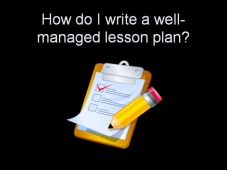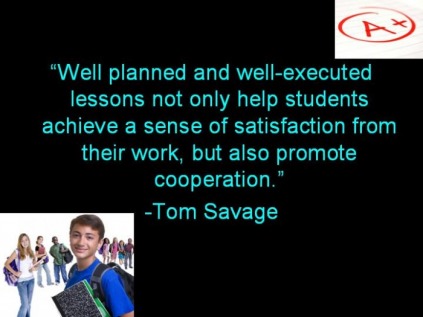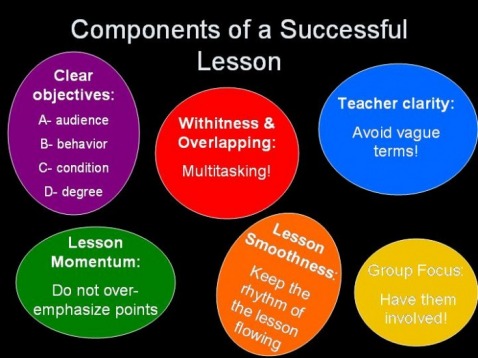Lesson Management

After understanding the one’s own perspective and the motivations of students, the teacher can examine the management of lessons. Having an effectively organized lesson is one of the essential elements of a well-managed class.
Description:
Lesson management refers to the planning and consideration that goes into the creation of an activity. It is an important aspect of maintaining management. The more children are engaged and interested in a lesson, the less likely they are to misbehave. A good lesson is comprised of five parts: clear objectives, teacher clarity, withitness/ overlapping, lesson momentum, lesson smoothness (including connected discourse and creative repetition), and maintaining group focus. (These will be discussed in greater detail below.) (Savage, 1999).
Significance:
“Well planned and well-executed lessons not only help students achieve a sense of satisfaction from their work, but also promote cooperation” (Savage, 1999). When students know what is expected of them, and it is enjoyable to them, they are much more likely to respond in a positive manner to the lesson. It builds confidence, rapport, and learning. Also, while initially lesson planning takes much time, it saves wasted energy and discipline time in the class, essentially saving time overall.
Demonstration:
Two fourth grade classes are learning about the California Gold Rush and the migration that ensued. In one class, the teacher has difficulty maintaining students’ interest, and there is much chatter and note passing. In the other class, students are out of their seats, actively engaged, and retaining information (as witnessed on test scores). Both teachers have the same material and are following the same standards. Then why is there such a difference? In the first class, the teacher uses their expertise to attempt to convey material to students. She has not thoroughly planned her lesson, because she knows this material well. As a result, she often uses vague terms and students have difficulty relating concepts. In the other class, however, the teacher has spent much time creating a lesson where students role-play various characters in history. They are thinking about who, what, where, when and why these events happened. As a result, they are engaged and taking part of their learning. The teacher is clear, and there are few to no management issues.
Integral Components:
The idea of clear objectives refers to the creation of success-based activities that are focused on objectives and provide the teacher with clear guidelines. One basic rule of thumb for this is ABCD objectives. A-audience, B-behavior, C-condition, D-degree. In other words, target lesson objectives to a specific people, doing a specific thing, under certain circumstances a number of times correctly. Similarly, teacher clarity is an essential skill. Avoid vague terms such as “approximations like ‘almost,’ ambiguous designations like ‘somehow,’ bluffing like ‘everyone knows,’ indeterminate quantification such as ‘a lot or a few,’ and probability like ‘generally and often’” (Savage, 1999). Also avoid “rabbit trails” or mazes. They lead to misbehavior from confusion. Withitness and overlapping refer to the teacher’s ability to multitask, keeping students working and interpreting their body language. Lesson momentum keeps the lesson on target by preventing fragmented instruction (using too many steps) and over-dwelling on concepts. Lesson smoothness maintains a steady rhythm in teaching the lesson, as well as speeding up or slowing down as needed based on students’ body language. This includes connected discourse, or the linking of parts in the lesson through clear objectives, and creative repetition, which is the review of points in a creative and new way. Finally, group focus keeps students on task by providing variety, keeping students accountable and having them involved. (Savage, 1999).
Individualization:
Lesson planning is one of the most critical aspects of teaching as it handles both aspects of teaching, instruction and management. I plan to use the methods above to provide clarity and consistency in my teaching. Not only will this allow for greater management, but more effective learning.
Spiritual Application:
One of the key aspects of lesson management is preparation. In the Christian life, we are to “be prepared in season and out of season” to preach the word. (2 Timothy 4:1-3) Though lesson management is not directly related to preaching the word, this command of being ready implies certain preparation. Therefore, applying this to all aspects of life would seem prudent as to build self-discipline. By incorporating preparation in lesson management, it becomes natural, and we are thus greater prepared when it comes time to preach the word.



